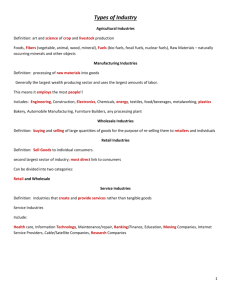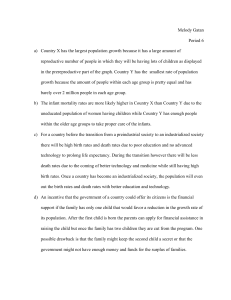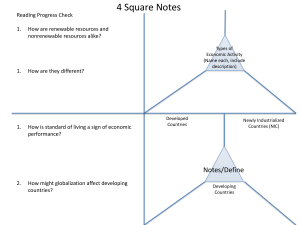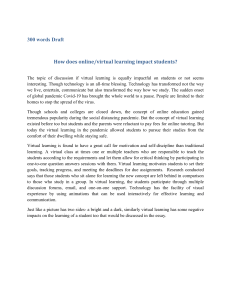A Lopsided Recovery for EMs and Developing Countries 1627007988
advertisement
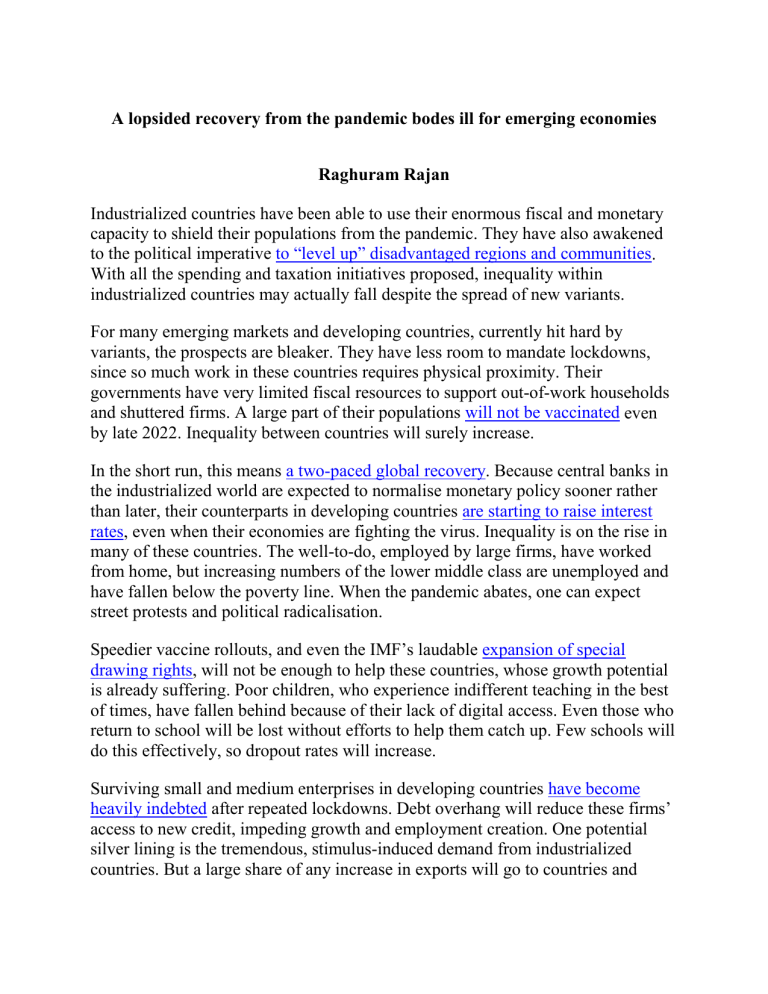
A lopsided recovery from the pandemic bodes ill for emerging economies Raghuram Rajan Industrialized countries have been able to use their enormous fiscal and monetary capacity to shield their populations from the pandemic. They have also awakened to the political imperative to “level up” disadvantaged regions and communities. With all the spending and taxation initiatives proposed, inequality within industrialized countries may actually fall despite the spread of new variants. For many emerging markets and developing countries, currently hit hard by variants, the prospects are bleaker. They have less room to mandate lockdowns, since so much work in these countries requires physical proximity. Their governments have very limited fiscal resources to support out-of-work households and shuttered firms. A large part of their populations will not be vaccinated even by late 2022. Inequality between countries will surely increase. In the short run, this means a two-paced global recovery. Because central banks in the industrialized world are expected to normalise monetary policy sooner rather than later, their counterparts in developing countries are starting to raise interest rates, even when their economies are fighting the virus. Inequality is on the rise in many of these countries. The well-to-do, employed by large firms, have worked from home, but increasing numbers of the lower middle class are unemployed and have fallen below the poverty line. When the pandemic abates, one can expect street protests and political radicalisation. Speedier vaccine rollouts, and even the IMF’s laudable expansion of special drawing rights, will not be enough to help these countries, whose growth potential is already suffering. Poor children, who experience indifferent teaching in the best of times, have fallen behind because of their lack of digital access. Even those who return to school will be lost without efforts to help them catch up. Few schools will do this effectively, so dropout rates will increase. Surviving small and medium enterprises in developing countries have become heavily indebted after repeated lockdowns. Debt overhang will reduce these firms’ access to new credit, impeding growth and employment creation. One potential silver lining is the tremendous, stimulus-induced demand from industrialized countries. But a large share of any increase in exports will go to countries and companies less affected by the pandemic. Global supply chains will be reconfigured to weed out weak firms, further hurting SMEs in hard-hit countries. The industrialized world can help by resisting all forms of protectionism, including unintended ones. They should examine their regulatory requirements on imports, which are hard for small producers elsewhere to meet. For instance, no one wants workers to work under unsafe conditions, but pushing stronger labour standards on Bangladeshi garment producers today, without commensurate assistance, may cause smaller ones to close. Likewise, the EU’s plans for a carbon border tax on imports will hurt the smallest exporters in the poorest countries, who often use the most carbon-intensive energy sources. One remedy would be to offer small producers enhanced carbon credits for emission reduction, which they could sell in industrialized countries’ markets. Another would be to actually contribute the annual $100bn promised by rich countries to poor countries in 2009 for climate adjustment, and slant the fund towards green investment by small and medium firms. Infrastructure investment, including in digital connectivity, is particularly useful for SMEs in developing countries. Multilateral institutions have been urged to get out of the comfort zone in which they extend safe senior loans to infrastructure projects in emerging economies. Instead they should provide risk capital that can draw in private investment. There is no better time than now for them to introduce this change. Digital connectivity and the rise of services at a distance during the pandemic offers another opportunity to spread incomes – think of the technologies that now allow a doctor in the Philippines to diagnose a patient in Canada. However, some existing impediments to cross-border transactions in services will have to be tackled. For instance, could industrialized countries make it easier for doctors who live in emerging economies to take licensing exams? Adverse shocks will not end with the pandemic. Emerging economies will be particularly exposed to the impact of climate change and growing geopolitical tensions. Even if images of hardships elsewhere fail to affect us, waves of migrants will. We need to build back better, not just within industrialized countries, but everywhere.

